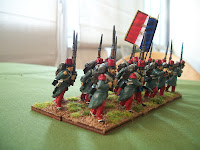As a result of an agreement between liberal Spain and France, the last gave support to Isabella sending the Foreign Legion which fought in Algeria.
1835
The legionnaires from Algeria disembark in Tarragona (19/8) and soon are joined with other recruits from France. At this time it numbers:
- 6 Superior officers
- 123 officers and medics
- 4143 soldiers from Algeria
- 571 soldiers from France (Pau depot)
- 343 horses.
During this year the legion fights in a lot of small actions in the north-western part of Catalonia: Balaguer (29/8), Guimerà (20/9), Granadella (27/9) and Tremp (17/11).
At the end of the year, the legion fights in Arguez in Aragon were the 5th bon. defends the village from a Carlist attack winning with odds of 1 to 10.
1836
Fights in the battle of Arlaban (16-17 /01) and is destined to Pamplona and its fortified lines. At this time, Bernelle creates 3 squadrons of polish lancers, a mountain howitzer battery with French and Spanish artillerist, an engineer company and a medical corps company including a stretcher bearers section (maybe the first one of this type in Spain). The legion is posted in the following places all near Pamplona:
- 1st bon. Zubiri
- 2nd bon. Urdáriz
- 3rd and 4th bons. medical corps, lancers battery and HQ at Larrasoana
- 5th bon. Zuviain
- 6th bon. Zabaldica and Archoriz
3500 Carlist occupy Tirapegui heights (26/4) thus threatening Larrasoana. Bernelle and all the troops there fight during 6 hours retreating in good order. The carlist attack Viscarret (16/5) and Zubiri (3/07) where Bernelle and two bons joints the troops of Brig. Clonard (2 Guard bons and Borbon rgt.) to repel the carlist attack. More Carlist attacks on Puente la Reina (17/7) and Zubiri again (30/7) are stopped thanks to the Legion.
Differences with the government and the lack of pays moved Bernelle to refuse the command of the legion. At first, Colonel Beau nicknamed Lebeau (The handsome) took command until the arrival of Brigadier Conrad (summer 1836). Conrad was loved by all his man as he knew a lot of them and spoke several languages encouraging them in their own mother tongue. Conrad was nicknamed “Der Alte Fritz” and rode a white horse.
At the end of this year the legion fought at Arroniz (14/09), Villalba (19/09) and Allo (21/12).
1837
In January the legion still has 3 infantry bons, the cavalry and the artillery. In March fights at Dos Hermanas (15/03) and Larrainzar (21/03).
When the Royal Expedition departs from the north, the legion is reduced to 2 infantry battalions, 2 cavalry squadrons and a mountain battery of six guns. With those forces starts the persecution of the carlists fighting them at Huesca (24/05) where it had 350 dead and wounded (23% of the total) and Barbastro (02/06) where the liberal legion, now only one battalion of infantry, fought its carlist counterparts in a vicious fight. In this last battle, Conrad was dead.
After this battle, the legion was almost destroyed and the last remnants, under orders of capt. Bazaine were sent to Pamplona as garrison troops where it remained until the end of the war.
In 08/12/1839 the last legionnaires, numbering only 500 were sent back to France.
Miniatures
18 miniatures from Perry painted using Vallejo acrylics and the Army Painter shades and varnish. The flag is from Adolfo Ramos.






















































